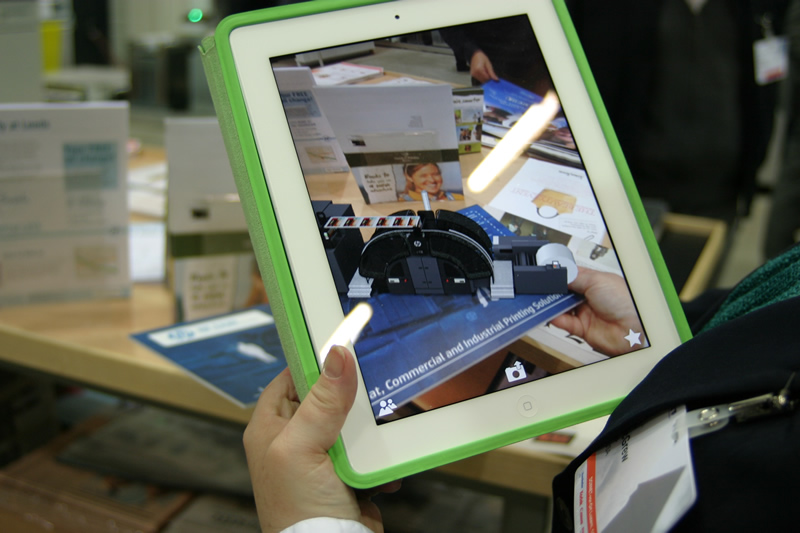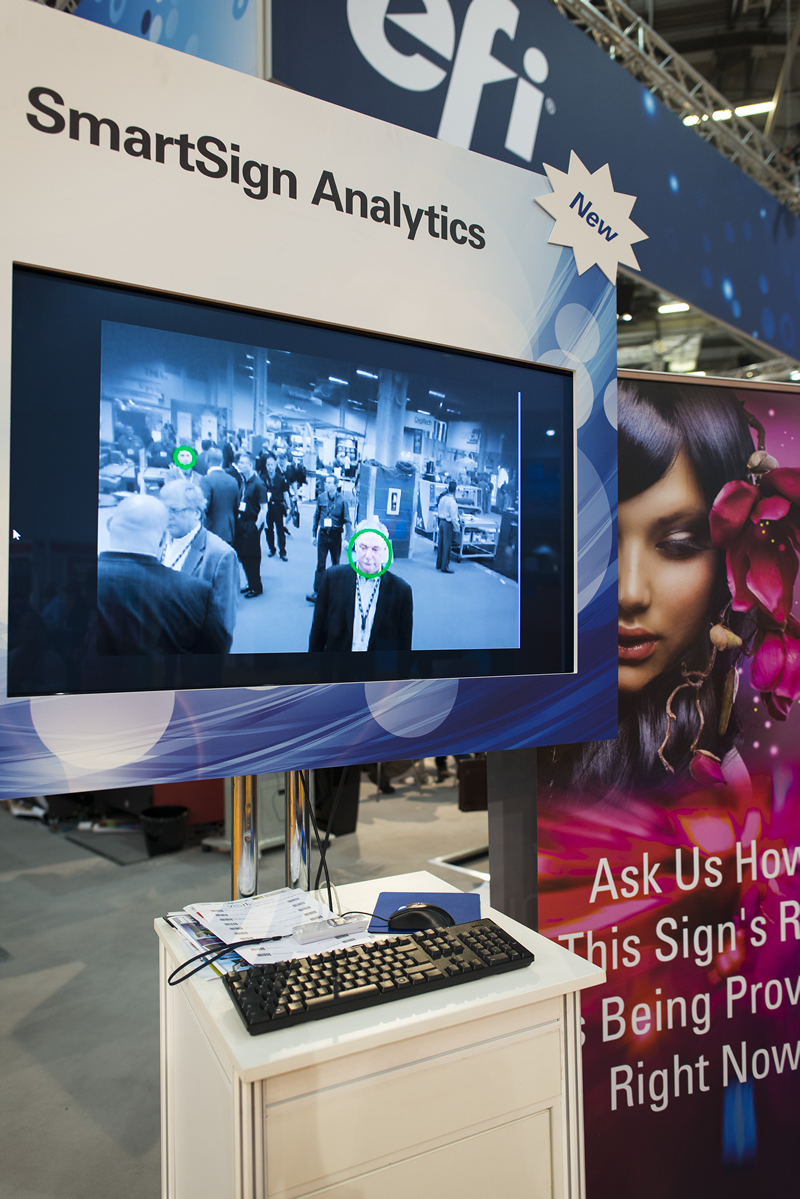It’s easier to sell wide-format graphics if you can demonstrate how effective they are, but how easy is that? Nessan Clearly finds out.
It’s relatively easy to track online viewing habits so that marketers can get a good idea of who’s viewing individual Web pages and whether or not they linger over particular adverts etc – useful data when it comes to planning campaigns. But a poster or a banner is an inherently static graphic so how do marketers know how effective it is? Herein has lain the rub for some time now. But things are changing.
EFI for instance, has developed a solution that it calls SmartSign Analytics, or SSA. This was developed by an American company, Online Print Solutions, which EFI acquired back in 2012. Essentially it uses a Webcam attached to a printed sign/poster and connected to a computer or tablet running facial recognition software. The key to the system is the additional SSA software that can analyse whether or not people are viewing that print, and how much time they spend viewing it. The system can also work out the gender and age range of each viewer, allowing it to quickly collect a treasure trove of demographic information directly linked to a particular location or sign. It even records how many people walk past, so that it can give a sense of the traffic flow at each location. It will allow marketers to work out how effective their advertising is but it could also be used to test different poster designs prior to rolling out a wider campaign. There’s a click charge attached to it but it could well help a PSP secure more work because of the analytical feedback it can provide.
It’s quite a discreet system as it only needs a small camera lens which can be hidden within the graphics. Nor should there be any privacy issues as EFI claims only to store the analytical data and not images of actual faces.
Some companies have also experimented with systems for tracking people in particular locations, such as shopping centres or train stations. The best known of these is iBeacon, developed by Apple. Essentially it uses a form of Bluetooth to communicate with a mobile device. Bluetooth is generally fairly low powered and iBeacon uses a version called Bluetooth Smart specifically designed for low energy consumption, so that the iBeacons need to be fairly close to the smartphone to work, which in turn means that the iBeacon can give a pretty accurate idea of a person’s location, down to just a metre or so.
Not surprisingly, it’s supported by iPhones, iPads and Macs, but is also used in many Android and Windows phones as well, making it a de facto standard for this sort of technology. Thus a typical use might be to locate the iBeacon by a poster advertising a particular product. As the smartphone approaches the iBeacon could then trigger details of nearby shops selling that product. It needs an accompanying app on the phone, which is pre-programmed with the relevant messages, since the iBeacon only transmits its presence. However, it is possible to tell how close a person came to the iBeacon and how long they lingered there so that you could gauge how long each person spent by a particular poster.
The iBeacons themselves come in different form factors such as coin cell batteries and USB sticks. It should also be possible to use iBeacons to trigger payments, though so far Apple has limited this functionality. The system depends on how well the app has been implemented in order to persuade people to use it.
Another alternative is Near Field Communications, or NFC, which has a much shorter range than the Beacon technology and is mainly used as a wireless payment system. This could be incorporated into a graphic – imagine, for example, a poster advertising a new eBook or a film with an NFC chip that allows you to download that book and pay for it.
Another commonly used data collecting method is to add a QR code to a poster and invite people to scan the code with their smartphones. This then opens an app or a browser window with more information. Thus, for example, a QR code could be used to trigger a train timetable from a station platform or a bus stop. Many people now view this as passé but it’s still an effective way of communicating with people, particularly as most people have a smart phone and there are plenty of free QR code reader apps.
Another variation is to use a form of augmented reality, which again relies on a smart phone or tablet. The idea is that you point the camera at the graphic, so that you’re viewing the graphic through the 
But in the meantime, providing you have the app then you can see the graphic plus additional information layered on top. Some augmented reality examples can be quite stunning. Imagine, for example, a poster for a new Hollywood blockbuster that can also show a clip from that film and directions to the nearest cinema, with an option to book tickets, or that can pull up reviews for the movie or even take you to an app store to download an accompanying app or game for that film.
Augmented reality has been around for at least a decade and there are several developers working on solutions that can be combined with wide-format graphics. The best known is probably Aurasma, now owned by HP. This current version of the system includes a cloud-based studio to help create augmented reality solutions. There’s also a rules-based engine to manage the solution in different environments so that one solution could be used, for example, in different geographical areas. It’s also possible to link the augmented reality solutions to Facebook and Twitter.
There are plenty of other developers around, such as Nth Degree, which has two separate divisions: one dealing with wide-format graphics; and the other in the development of augmented reality solutions. The company also acts as the UK distributor of OnVert, an augmented reality solution that can also read QR codes, which is a useful way of getting around the need to have the right app installed. OnVert can allow for 3D projections as well as up to 30 seconds of sound, enough to allow you to sample a new song with a link to an app store to purchase it.
Finally, it’s worth mentioning that it’s possible to link a sensor to a display to trigger a change. So, for example a light box could be fitted with both red and blue lights to give alternative warm or cold effects, which could be triggered by a motion detector as people approached for a degree of interactivity. It’s already possible to do something similar with digital signage, such as adding a sensor to detect rain that could then trigger an advert for an umbrella.
In conclusion, it’s possible to add interactivity to a wide-format graphic, and to collect data about how people view/use that graphic.
These solutions have different time and expertise requirements when it comes to implementation, but that’s a service that can be charged for – especially if you can demonstrate feedback from the intended audience.


